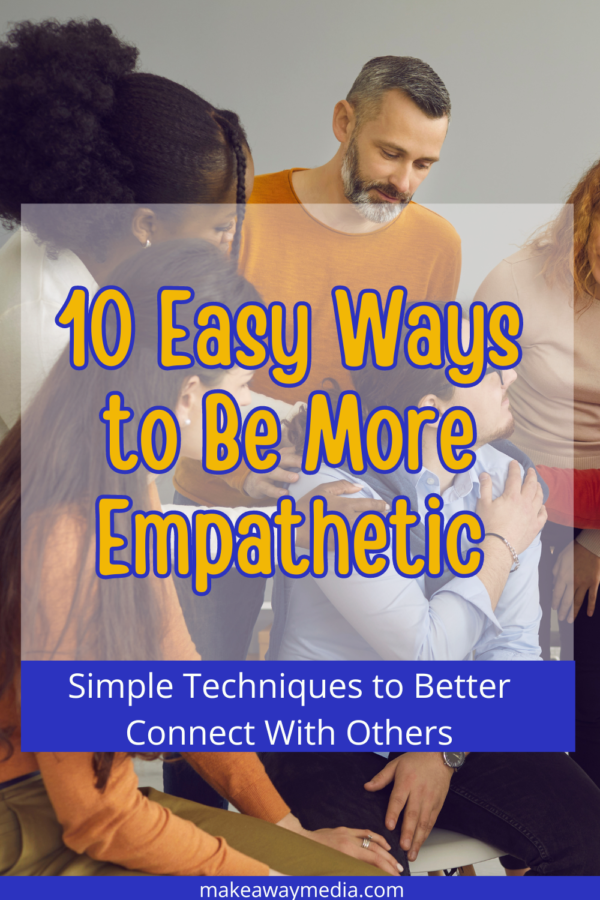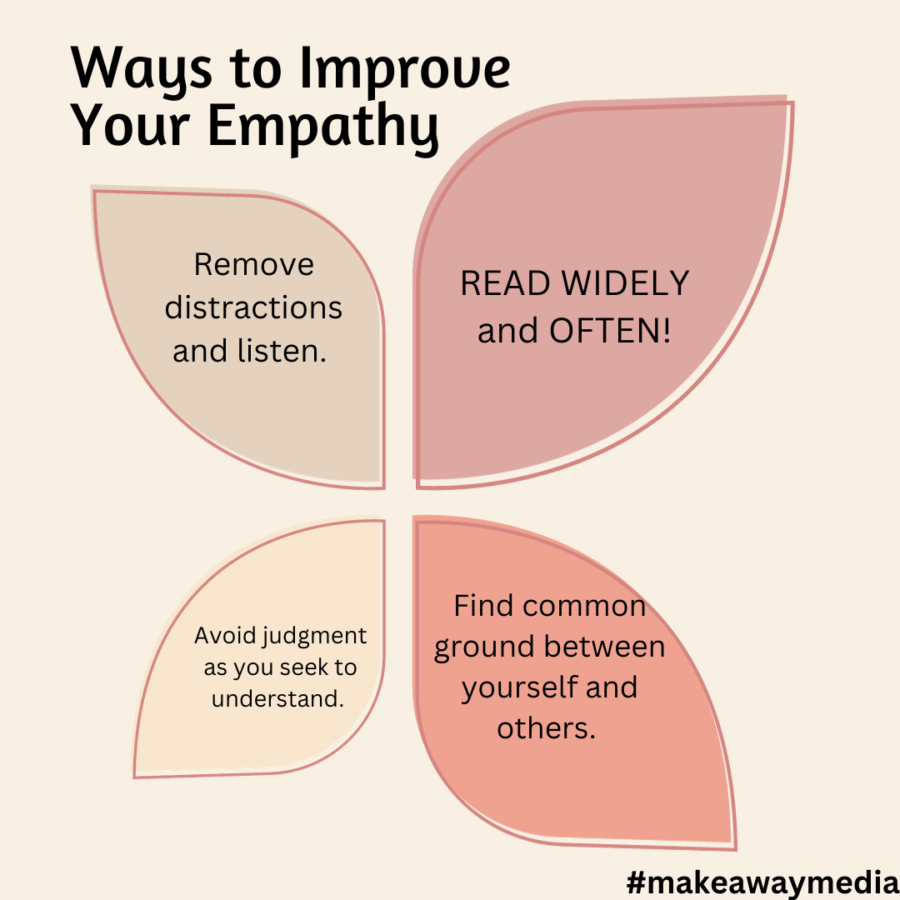10 Ways to Show Empathy
Empathy—why does it feel like it’s a dying art in today’s fast-paced, “all about me” world? Showing empathy isn’t necessarily difficult, but it does require intention and the ability to look beyond your own feelings. (OK, maybe that is difficult sometimes…)
Amid the constant buzz of technology and our busy schedules, focusing our attention on others, and putting ourselves in another person’s shoes, has become more and more challenging.
Yet, being empathetic is an essential part of meaningful relationships. You need empathy skills at home, at work and even when you are out in your community. Here are 10 ways to show empathy in everyday life.

What is empathy?
Empathy is a huge part of emotional intelligence. It is the ability to notice and understand, or even feel, other people’s emotions.
There is cognitive empathy which is knowing (in your head) how someone else feels. Then there is emotional empathy, where you actually feel what the other person feels.
Both go beyond sympathy, which is basically just feeling pity for another person. Instead, empathy means putting yourself in the other person’s shoes and imagining or even share the feelings that they may be feeling.
When we experience empathy, we feel deeply seen and understood, often strengthening our relationship with the other person. When we show empathy we are able to develop a deeper understanding of someone else’s experiences, making us a more empathetic person and often sparking compassion to help do something about the situation.
Why should you be practicing empathy?
Empathy is crucial in both personal and professional settings because it promotes open communication, reduces conflict, and increases cooperation.
By practicing empathy, we not only support those around us but also create a more compassionate and connected world. Empathy helps build trust and fosters stronger relationships. It shows others that you truly care about someone else’s well-being.
Wether you are at work or with your kids, the ability to practice empathy is your key to connection.

7 Simple Ways to Demonstrate Empathy in a Conversation
1. Turn Your Devices on Silent
We are so afraid of missing something on our phones, watches, tablets, and computers that we miss the things right in front of us. Most of us have experienced the frustration of talking to someone completely distracted by their device.
Although this step is a common courtesy more than an actual act of empathy, it is the precursor to making people feel seen and heard. Silence your devices and give your full attention to those you’re with.
2. Just Listen–Don’t Fix
It’s hard to not jump in and want to fix someone else’s problems, isn’t it? I can’t tell you how many times, as a therapist, I have wanted with every fiber in my being to tell my clients what to do.
The reality is, most people just need a safe space to vent. They don’t want you to swoop in and solve the issue. They just need to be heard.
Resist the urge to offer unsolicited advice and focus on listening. Often, a person will be able to figure out how to respond to their dilemma on their own just by talking it through with someone else.
3. Use Active Listening Skills
Active listening involves more than just hearing words. It means listening with your full body and mind. Your body language says just as much about your interest in the conversation as your words.
Maintain eye contact (when its appropriate), nod in agreement, and sit facing the person talking to you.
(Did you know that a lot of us do this automatically? Because of mirror neurons, we often mirror the body language of the people we are talking to without even realizing it!)
4. Give Empathetic Responses
Reflecting back the emotions you are hearing or seeing validates people’s feelings and show empathy. Simple statements like, “That sounds really tough” or “You must be feeling really happy about that” can go a long way in making someone feel heard. It proves you are paying attention and picking up on their emotions.
5. Ask Questions
When someone shares a problem, asking questions can give you a deeper understanding and help them find their own solutions.
Ask questions like, “Can you tell me more about that?” or “If you could do it over, what would you change?” These prompts can guide them to a resolution without imposing your opinions.
(It’s important to keep your own opinions to yourself unless they ask you for them.)
6. Validate
If someone is brave enough to be vulnerable and share their feelings with you, validation is a great way to make the person feel understood.
Acknowledge their feelings and experiences without judgment. Phrases like, “I can see why you feel that way” or “That must have been really challenging for you” prove that you understand their perspective.
7. Follow Up
Empathy doesn’t end when the conversation ends. Check in with the person later to see how they’re doing. A simple message or call can show that you genuinely care about their well-being.

3 Ways to Show Empathy in Any Situation
Although the first 7 tips focus on having empathy with someone we are in a conversation with, I find it is hardest for us to have empathy with the people we don’t know well. These last tips will help you have empathy with anyone, anywhere.
1. Accept Different Opinions
Contrary to popular belief, it truly is okay to disagree. The ability to understand multiple perspectives around the same topic is a sign of deep emotional intelligence.
Although your own emotions might start boiling during conversations where you don’t see eye to eye, empathy is a two way street. Set aside your preconceived notions, show respect and keep listening anyway. It’s pretty likely that the other person will do the same. By the end, you will both have gained a new perspective and maybe even a new friend.
(My book This is Earth shows how we can use the language of empathy and treat one another with respect and understanding.)
2. Imagine The Person’s Life
If you find yourself feeling apathetic about a situation, take the time to imagine what it would be like to live that situation, to be the person experiencing that hardship. You’ll probably find yourself feeling more empathetic pretty quickly.
3. Respond to Apathy
If you notice that someone else around you is struggling to accept certain situations or show empathy to others, push back against their responses. Help them hear their other side of the story and why the issue matters. Modeling empathy is a great way to help other people learn to empathize too.
Model Empathy Every Day
If we all focus on showing empathy each day, to our kids, our coworkers, and the people around us, the world would be a better place.
Empathy is about understanding others’ feelings. Compassion takes it a step further by wanting to do something about it. Unfortunately, we can’t get to compassion though without letting ourselves feel empathy first.
To help parents and educators raise empathetic kids who truly believe they have the power to change the circumstances around them, we created the K Club.

It is a free online membership for kids ages 6-11. You will get a monthly guide full of fun activities to help your kids and students learn the social emotional skills they need to thrive.
Remember, we CAN make this world a more empathetic place. All it takes is a little intention.


